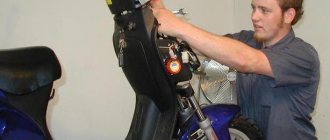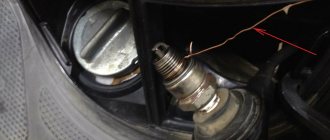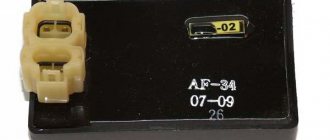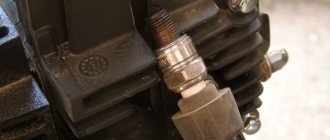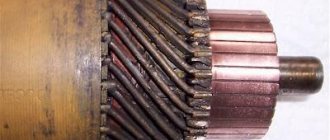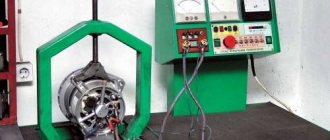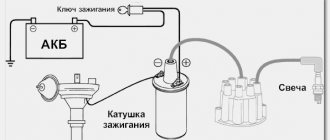Many people who bought Honda Dio scooters were sure that a speed of 50 km per hour would be enough. “Why go faster, it’s better safer, but with less consumption.” However, when some time passes after the purchase, the owner will want more speed in order to get to his destination faster.
After this thought, the owners are thinking about tuning their budget scooter and transforming it into a high-speed two-wheeled “Monster”. It's funny, but many people call this budget miracle exactly that. You can, of course, buy and install a Japanese-made tuning piston engine on a Honda Dio, but its cost is more than $200. And installing a piston engine of such a cost on a device that costs about $500 is, to put it mildly, not rational. It’s easier to just initially buy a 100 cc scooter and enjoy it without any tuning. Therefore, it’s better to just do the tuning yourself and add speed to your scooter without spending huge amounts of money on it.
Before you start disassembling the scooter and start improving the device, you need to figure out whether your scooter is configured correctly. It is quite possible that if you clean the exhaust pipe, air filter and adjust the carburetor, then your Honda Dio will simply “fly” along the roads.
Tuning Honda Tact, Dio scooter with AF24E engine
In this article I will tell you how, for a very reasonable amount of money, you can significantly increase the dynamics and power of a Honda Tact or Dio scooter equipped with an AF24E engine.
By the way, tuning is a thing that knows no boundaries, rules and limits on the path to perfection. But the purpose of this article will not be to discuss tuning as such, but to talk about how you can significantly improve engine parameters while spending a minimum of effort and money. For those who don't know, two-stroke engines, by their nature, are very responsive to increasing engine displacement. Unlike four-stroke engines. In four-stroke engines, engine power largely depends on the design and configuration of the cylinder head, but in two-stroke engines, the cylinder head does not have such a significant effect on engine power. Therefore, any, even small, increase in the volume of a two-stroke engine gives a significant increase in power over the entire engine speed range.
So, we go to the store and buy a piston with a volume of 72 cubic centimeters (47mm). I bought myself this one, it costs 1,300 rubles, but taking into account the discount, it cost me only 1,100 rubles.
For comparison: on the right is a piston (not original, the engine has already been removed from the farm, and quite “successfully”...) with a volume of 58 cubic centimeters (42mm), and on the left is a piston, which we will install with a volume of 72 cubic centimeters (47mm).
A few words about the piston: its manufacturer is Chinese a la noname, so you shouldn’t expect high service life and workmanship from it. There is no gasket for the cylinder head and cylinder in the box and they have to be purchased separately. There is no protective coating on the piston, and this is not good, although for a two-stroke engine the lack of a protective coating on the piston is not a critical point, but still...
The cylinder has a five-channel purge with a well-developed network of purge windows, which has a very positive effect on increasing power, especially in the high-speed zone.
The piston rings have clearly readable markings and their appearance inspires confidence. At the very least, it is difficult to make any complaints about the geometry and cleanliness of processing.
Now about the sad thing: it is not possible to install this piston engine without disassembling the engine and modifying the crankcase... But tuning, as we know, “requires sacrifices,” so if we want to significantly increase the power and dynamics of the scooter, then like it or not, we will have to disassemble the engine a little file the tides marked by arrows in the crank chamber.
The tides can be cut with a file, or they can be cut with a well-sharpened chisel. I cut it down with a chisel.
The second unpleasant point, and maybe not so much, is that the standard pump of the engine lubrication system will not be able to provide the proper level of lubrication for a piston of increased volume, and therefore with a larger working area. Therefore, when operating a scooter with a larger piston engine, you should add a little oil to the fuel tank of the scooter. In principle, this is where all the troubles associated with this piston engine end.
After modifying the crankcase, you should thoroughly wash all engine parts from any remaining metal shavings and abrasives, reassemble the engine in reverse order, and only then can you begin installation.
This piston is installed according to the same principles as any other piston for a two-stroke engine. The only difference, or most likely difficulty, is that there are no marks on the bottom of the piston that would allow the piston to be correctly positioned in the cylinder.
Therefore, when installing the piston on the crankshaft connecting rod, orient the piston so that the piston ring lock pins point strictly at the purge port located in the diametrically opposite direction from the exhaust port.
After installing a 72CC piston and proper running-in, the scooter significantly increases dynamics and power. Believe it or not, but with skillful handling of the throttle and at the same time playing along with the body, the scooter easily stands on the rear wheel while leaving Chinese garbage dumps of various kinds far behind...
Source
Checking the Pulse Generator
We measure the resistance of the Hall sensor coil at the switch connector. We set the device to 2 kOhm. We connect one probe to the green wire, and the second to the s/w. Should be 114 ohms. This means the wiring and Hall sensor are working properly.
If the circuit does not show resistance, then this indicates a break in the coil or electrical wiring from the pulse generator to the switch.
Next, we check the functionality of the entire pulse generator along with the mechanical part. Switch the device to 2 mA, leaving the probes in place.
We pull the leg of the kickstar. From the Hall sensor, for one rotation of the magneto, one pulse with a small current is supplied to the commutator. The meter should show approximately 0.6 mA. This means that all elements of the pulse generator are working properly and the reason for the lack of spark is not in the Hall sensor.
If the device does not show current, then you need to remove the air cooling casing. Look at the gap in the mechanical part of the generator, between the magneto and the Hall sensor. Check to see if the crankshaft bearings are loose or if the wire from the sensor is broken.
Tuning the Honda Dio scooter
Honda Dio is a Japanese scooter, quite light, compact and maneuverable. Very common in the CIS countries and easy to tune. Therefore, many owners of such scooters strive to improve it, preferably at the lowest possible cost. Generally, the top speed of Honda Dio is 50-55 km/h. It is factory installed for this scooter model. increase engine power and accelerate to 75 km/h with little effort and finances. Otherwise, tuning a Honda dio is a constant path to perfection, and no one forces anyone to stop.
Chassis
The big advantage of this scooter is the fact that its front suspension is made in the form of a telescopic fork. As for the rear suspension, it is a shock absorber, also equipped with a spring assembly. There are two brakes at once - both front and rear. In both cases, they are drum-type, which gives excellent control not only over the control of this scooter, but also over its braking
The result is a vehicle that definitely deserves the attention of those who are not yet ready to get on a motorcycle, but already want to ride on two wheels and gradually join the environment
How to increase the speed of Honda Dio with minimal investment? Budget scooter tuning
In this case, the increase in speed will not be significant, however, these actions can be dispensed with if you want the scooter to travel at a speed of 60–65 km/h. We configure everything we have. First, we clean the purge channels and exhaust from carbon deposits. This can be done using lye. It is also called caustic soda or caustic soda. Sold in hardware stores, it is very cheap - up to 20 rubles. It is best to clean with rubber gloves, otherwise you will get a chemical burn. After cleaning, the engine runs much easier. It is worth adjusting the transmission, especially if you bought the scooter second-hand. These often use outdated components, so buy a set of springs and weights in advance. For a sharp start and quick acceleration, stiff springs are installed, but at low speeds the scooter will behave unpredictably. Weights are needed to adjust the variator. To select them at the required weight, it is necessary to achieve full extension of the belt to a large radius. The lighter the load, the higher the engine speed and vice versa. If you are underweight, you will not be able to accelerate to maximum speed. All these actions will allow your scooter to accelerate to 60-65 km/h. If this speed is not enough, the next part is for you.
Sports CVTs
It's hard to imagine tuning a scooter without improving dynamics and increasing maximum speed. For a smoother change in the speed of the driven shaft, we suggest purchasing the following models of sports variators:
- variators HondaDioAF-18, HondaDioAF-27 / GY6 50CC (for a thin shaft of 12mm and 14mm, respectively) - suitable for tuning Honda Dio scooters, allowing to improve the maximum speed and dynamics of the vehicle;
- CVTs Yamaha Jog 3KJ, Yamaha Jog90/Stels – suitable for scooters of the corresponding model range; The pulley diameter has been increased by approximately 3mm, the shape of the grooves has been changed in such a way as to achieve maximum divergence, and weights of different weights are supplied in the kit for more precise adjustment.
- mechanical continuously variable transmission GY6 125-150CC - suitable for the engine of the specified model or Chinese analogues, provides an increase in the speed of the motorcycle and improves its dynamics.
Full tuning
In order to significantly improve engine performance, you will have to put in more effort and finances. So, first you need to purchase a piston system with a volume of 72 cubic centimeters, 47 millimeters in diameter. Its cost is approximately up to 1.5 thousand rubles . This price is often made in China, so you shouldn’t expect excellent quality. Such a piston has a short service life, and the kit does not include some parts, such as the cylinder head gasket and cylinder. You will have to buy them separately, since without this nothing will work. There should be five scavenge channels in the cylinder to significantly increase engine power and also soften the load on it at high speed. The wheels on the piston group should look reliable, well machined, and the inscriptions on them should be clear and easily legible. Any chips, cracks, or scratches should alert you; installing such parts can be dangerous.
Further, some difficulties arise, since without disassembling the engine, installing a piston is not possible. And also with such tuning, the supply of lubricant to the pistons begins to work poorly. This problem can be solved by adding oil to the fuel tank of the scooter during operation. In addition, the catheter should be modified. To do this, first disassemble the engine and slightly file the tides in the crank chamber with a file or chisel. Afterwards, treat the cuts and wash them so that no metal particles remain. Now you can begin installing the piston. A scooter piston system is installed just like any other, but it can be difficult to determine the correct side. The main thing in the installation is that the cylinder pins are directed towards the purge window. You can also process the edges of the vent windows so that their edges are smooth. After all these steps, you need to put the scooter back together and run it at low and medium speeds. Immediately after assembly, we do not recommend immediately accelerating and squeezing the maximum out of the vehicle; it is better to increase it gradually. After a few minutes of driving, you can already increase the speed to 70–75 km/h.
Why do you need a speed limiter on a scooter?
There are strict restrictions on scooters in the Russian Federation. Such mopeds can reach speeds of up to 50 km/h , this is an artificial reduction in the capabilities of transport. For more powerful engines you already need a license. Therefore, manufacturers try to protect themselves and set a maximum speed limit. Therefore, a very common tuning of this type of transport is changing the settings of the CDI . In most scooter models, an additional wire is installed during production that regulates engine speed. Accordingly, if this wire is removed, your moped will be able to accelerate to 60–70 km/h. Newer models do not have such a wire. Their tuning can be done by replacing the CDI . In certain models and brands of scooters, in addition to such a limiter, there is another one. This is an additional mechanical limiter that prevents the pulleys in the engine from moving and making it work more powerfully. If you encounter this, we do not recommend removing it at home. It is better to contact a specialist, otherwise this will entail the removal of warranty obligations (if they still exist) and the possibility of damaging the device. After this, the scooter stops working and needs long and difficult repairs. Some manufacturers limit engine power by increasing exhaust resistance. To remove the restriction in this case, it is necessary to redo the muffler or change it to a sports version. It is worth removing all types of limiters if the scooter's mileage is at least 1 thousand kilometers. Regarding the main component, you should choose a carburetor based on the ease of its setup and size. The large size is important for the sensitivity of the engine. But despite all the simplicity, fuel consumption will be slightly increased. Thus, the Honda Dio can be improved and added power without any special physical and financial costs.
Source
Equipment and safety
The modification in question is equipped with drum brakes; on more modern models, the front unit is of a disc type. Despite its effectiveness, it requires more careful maintenance since it is open and susceptible to contamination.
The Honda scooter is equipped with a spacious trunk located under the saddle of the unit. There are no pockets for tools and other small items in the front part. Due to its reliability, ease of maintenance and cost, this moped has remained popular for almost two decades. With proper care and timely replacement of consumables, it will serve the owner for a long time, without losing its main indicators.
Increasing the piston volume to 76 cc on the Honda Dio scooter
Any scooter tuning is limited to certain limits and has a limit.
The limit is determined by the financial component (for the purchase of high-quality expensive parts), the capabilities of each specific engine (not all engines can be boosted equally well) and the need of the scooter owner (exactly why he is tuning the scooter). The last factor should be decisive, namely, why do you want to increase the dynamic and speed performance of your scooter? What goals are you trying to achieve and will it pay off in the future? Often scooterists engage in pseudo-tuning, not understanding the possible consequences for the equipment.
Scooter tuning and reducing engine life
It is important to understand that any boost to the engine definitely leads to a decrease in the reliability and overall service life of the engine components. Increasing volume and maximum speed inevitably leads to premature wear of the standard main bearings and crankshaft. When installing a piston with a volume of more than 62 cc, there is a need for additional adjustment of the oil and gasoline supply.
Advantages
Despite the small engine capacity, the technology in question remains popular for a long time. Honda Dio AF18 scooters are optimal for traveling on asphalt. In urban conditions, this is an indispensable option for lovers of light motorcycles not intended for racing and high loads.
The front telescopic suspension unit has some rigidity and adjustable travel, which allows for good maneuvering on the roads. The wheels grip the surface well, allowing you to take almost any turns perfectly. Shock absorbers are very sensitive to potholes and uneven roads. Nevertheless, even if the elements fail, they can be replaced without problems in most specialized workshops. On dirt roads you will have to get used to the shaking, but at low speed it is quite possible to overcome such sections.
